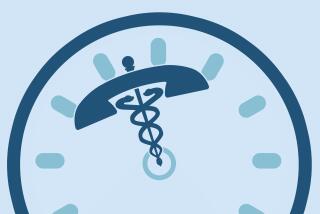State Study Triggers Fear of Wider Spread of AIDS
Medical experts say that every day, another 20 to 25 Americans learn they have the deadly disease AIDS. As of last week, 15,172 cases of acquired immune deficiency syndrome had been diagnosed in the United States and 7,777 people had died of it.
There is growing controversy in the medical community over the accuracy of these numbers, however, spurred by suggestions that physicians may not be reporting all AIDS incidents and deaths.
The latest example is an unpublished study by the California Department of Health Services saying that AIDS deaths in the state may be under-reported on death certificates by as much as 17% and that more than a third of the unreported cases are in married men.
As of Oct. 31, 3,378 AIDS cases and 1,438 deaths had been reported in California.
The Health Services Department report, based on a computerized check of death certificates, was completed in October by the department’s Medi-Cal section. It apparently is the focus of dispute within the department.
“However concerned we have been about AIDS, we should be at least 17% more concerned,” said Gary F. McHolland, an actuary who wrote the study with colleague Wes Weller. “A major concern is if this means that physicians are knowingly not reporting AIDS cases.”
Dr. Robert E. Anderson, chief of the department’s AIDS section, characterizes the report’s conclusions as “curiosities” needing further investigation. Anderson was not involved in the preparation of the report, but has been active in the department’s review of the data.
“There are many potential sources of error,” he said in a telephone interview. “Everyone in this business thinks there is some under-reporting of AIDS cases, but most people don’t think it is as great as what they found.”
At issue is how much of the under-reporting can be attributed to physicians deferring to the wishes of dying patients or their families if they ask that AIDS not be listed on death certificates.
The under-reporting question has implications for the financing of AIDS treatment and research and for restraining spread of the disease among heterosexuals and to areas of the country where it is not thought to be a significant problem.
Although physicians have been legally required to report AIDS cases at the time of diagnosis since 1983, some doctors express private concerns that a significant number of patients are going to their graves with the diagnosis a secret.
AIDS experts caution that diagnosing the disease and confirming it as a cause of death are often difficult. Patients do not usually die specifically of AIDS. As a consequence of the destruction of the body’s immune system by the AIDS virus, victims succumb to a variety of infections or tumors. These infections or tumors, not AIDS, may appear to be the underlying disease.
Sometimes doctors find themselves forced to choose between a full accounting on the death certificate or meeting the wishes of a dying patient who may want to keep knowledge of his homosexuality from loved ones and who may ask that AIDS not be included as a cause of death.
(Death certificates have places to list primary and secondary or contributing causes of death, and physicians have discretion in how they fill them out.)
A spokesman for the state Bureau of Medical Quality Assurance said that there are no specific penalties for failure to report infectious diseases but that “repeated willful failure” could make a physician liable for reprimand or revocation of his or her medical license.
Although the unpublished state Health Services Department study has received skeptical reviews from experts inside and outside the department, it was defended by McHolland in a telephone interview as being “definitive” and the best study of its type ever done on AIDS.
The conclusions are similar to those of a survey of 650 primary-care physicians in Los Angeles County in the fall of 1984, which found “significant under-reporting” of AIDS, according to Dr. Charles E. Lewis, a professor of medicine at UCLA, who directed the survey. The physicians could confirm only 70% to 80% of the time that AIDS cases they had knowledge of had been reported to the county, he said in an interview last month.
Contrasting Studies
The conclusions contrast, however, with a Los Angeles County Health Services Department study of AIDS surveillance and with reviews in San Francisco and New York, all of which found under-reporting to be minor. A spokesman for the federal Centers for Disease Control in Atlanta said, “We do not have any data that suggests that under-reporting of AIDS is a major problem nationwide.”
The situation is murkier still because the state health department has released a summary of the study’s findings and has made the authors available for interviews last week without providing the report’s methods or the text, which is still being reviewed in the department.
This decision and the quality of the report were defended by John Rodriquez, a deputy director of the department and chief of the Medi-Cal section, as necessary to make important information about AIDS, including data on costs and life expectancy, available to health officials and the public.
“I am not aware of any controversy within the department about the numerical conclusions,” he said. “There is room for different understandings and opinions, but I don’t view this as a controversial subject.”
In addition to finding that 17% of AIDS cases are not reported, the state actuaries found that 8% of other cases are not reported until the patient dies, a delay that--if the figures are correct--would further understate the extent of the disease.
Higher Risk for Women
Six percent of reported AIDS deaths were in married men, compared to 35% of the unreported deaths, according to McHolland, suggesting that a number of women may unknowingly be exposed to the virus that causes the disease.
McHolland said under-reporting was analyzed by reviewing the deaths of identified male AIDS victims in the state between the ages of 18 and 60 from 1980 through June, 1985.
Using computer tapes of death certificate data, deaths of known AIDS patients were compared to the total number of deaths of men in the same age group from six specific diagnoses that are usually indicative of AIDS, according to McHolland, although AIDS may not have been mentioned on the death certificate. These diagnoses include disorders of the immune system, infections such as pneumocystis carinii pneumonia or cytomegalovirus, and malignant skin tumors indicative of Kaposi’s sarcoma.
Critics of the study, and McHolland himself, say there could be a number of explanations for at least part of the under-reporting aside from doctors not recording an AIDS diagnosis on the death certificate.
For example, the study could not distinguish between a failure of physicians or hospital personnel to report AIDS cases to the county and problems with compiling and transmitting the data at the county and state levels.
Strict Definition
Also, health officials often learn of patients suspected of having AIDS who are not officially classified as victims because they do not meet the strict case definition established by the federal Centers for Disease Control. Laboratory evidence as well as the physician’s clinical judgment are required for AIDS classification. A patient might, for example, die before completion of a necessary test to confirm the diagnosis.
Anderson said studies are under way to determine if these reasons account for much of the under-reporting found by McHolland and Weller.
AIDS experts also cautioned that the findings need to be checked because the report is based on death certificate data, although health department statistics primarily use information from doctors, nurses and hospital laboratories.
“This report could be very misleading because it is not altogether clear what they did,” said Dr. Dean Echenberg of the San Francisco Department of Public Health. “I wish they had put out their methods at the same time they put out their results.”
Public health officials in the major urban areas where AIDS is common have conducted their own reviews of case reporting. Dr. Betty Agee, chief of acute communicable disease control for Los Angeles County, said she has no evidence of significant under-reporting.
One Case Missed
“I don’t have the impression that (under-reporting) is as frequent as it was earlier,” Agee said. “Reporting is better for AIDS than other (diseases).” When county epidemiologists reviewed last winter’s AIDS deaths earlier this fall, they found only one case that was missed.
The incidence of under-reporting of AIDS was not intended as the principal target of the state report. It was aimed mainly at determining the cost of the disease for the state’s Medi-Cal program, which pays for medical care for the poor.
The average lifetime medical costs for an AIDS patient were calculated to be $59,000 under the Medi-Cal program and $91,000 for patients with private insurance. Lifetime medical costs under Medi-Cal, based on fiscal year 1984-85 prices, were $70,000 in Los Angeles and $52,000 in San Francisco.
The study found that AIDS patients are hospitalized about once every three months and stay in the hospital an average of 14 days. There was a significant difference between the average length of a hospital stay in Los Angeles--17.9 days--and the average in San Francisco--12.1 days.
Medi-Cal pays for the care of 12% of AIDS patients, and McHolland said that before the study, it was thought that a much higher percentage of patients was covered. The average daily hospital cost of $606 under Medi-Cal was “no more expensive” than for non-AIDS patients. Total Medi-Cal cost for patients with the disease in fiscal year 1984-1985 was $4.5 million.
AIDS IN CALIFORNIA
About 12% of patients with AIDS in California receive Medi-Cal benefits. Those in Los Angeles received more in 1984-85 than those elsewhere in the state:
State L.A. S. Fran. Lifetime Medi-Cal cost per patient* $59,000 $70,000 $52,000 Length of hospital stay (in days) 14.0 17.9 12.1
* Includes hospital and physician fees. 91% of total cost represents inpatient care. These are characteristics of 3,056 reported California AIDS patients:
ETHNICITY 83% White
8% Latino
8% Black
1% Asian
AGE/SEX 98% Male
85% Age 23-47
RISK GROUP 83% Homosexual Male
10% Bisexual Male
2% Intravenous Drug User
1% Hemophiliac
RESIDENCE 41% San Francisco
36% Los Angeles
More to Read
Sign up for Essential California
The most important California stories and recommendations in your inbox every morning.
You may occasionally receive promotional content from the Los Angeles Times.










